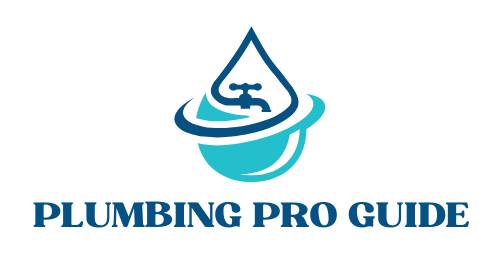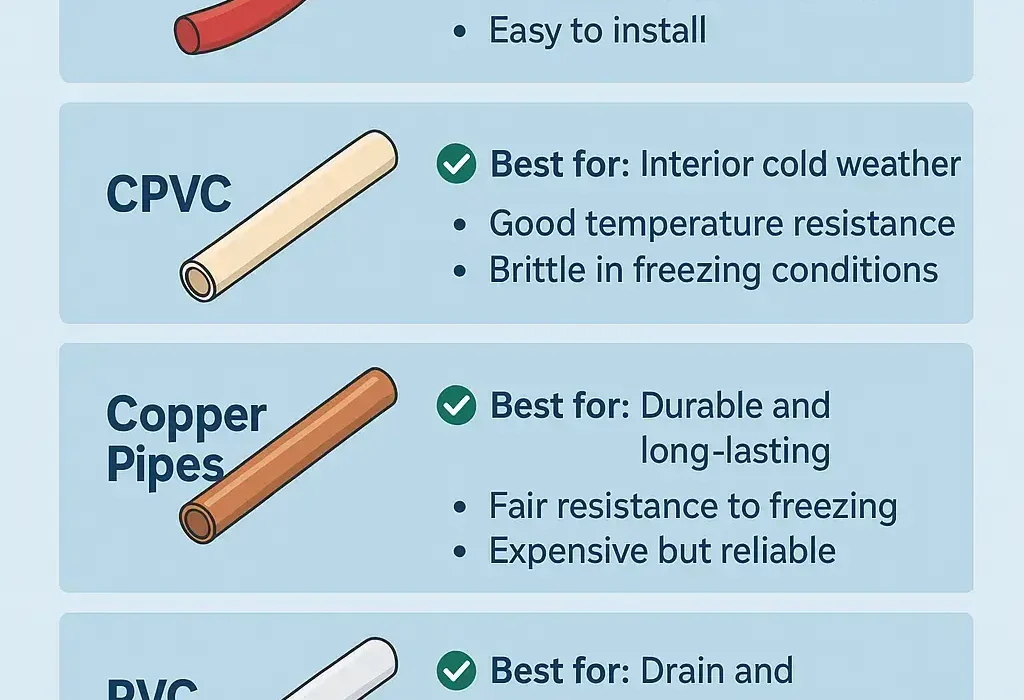Plumbing pipes for cold weather play a critical role in protecting your home from freezing temperatures and costly water damage. When winter hits hard in the U.S., frozen pipes are one of the most common and costly plumbing problems homeowners face. A single burst pipe can cause thousands of dollars in water repair but with the right plumbing pipes for cold weather, most of these problems are preventable.
If you live in a state where temperatures regularly drop below freezing such as Minnesota, Michigan, Wisconsin, Colorado, or upstate New York, choosing the right plumbing pipes for cold weather is crucial. This guide explains the best types of pipes for cold climates, their pros and cons, and tips to keep your plumbing safe all winter long.
1. PEX (Cross-Linked Polyethylene) – The Best Overall Choic
Best for: Homes in areas with extremely cold winters
Temperature Resistance: Excellent
Cost: Moderate
PEX is hands down the most popular choice for plumbing pipes for cold weather and for good reason. Its flexibility allows it to expand and contract without bursting when water freezes. This quality makes PEX far more resilient than rigid materials like PVC or copper.
Key Benefits:
-
- Expands under freezing conditions instead of cracking.
-
- Easy to install and less prone to leaks due to fewer joints.
-
- Resistant to scale and chlorine damage.
-
- Works well with both hot and cold water.
Drawbacks:
-
- Sensitive to UV light — not suitable for outdoor or exposed use.
-
- Can be damaged by rodents if not properly protected.
Pro Tip: If you’re replacing old copper or galvanized pipes, PEX offers an easy retrofit solution with push-fit fittings like SharkBite. Learn more in our plumbing pro guide for step-by-step plumbing DIY tips.
2. CPVC (Chlorinated Polyvinyl Chloride)
Best for: Interior cold-weather plumbing systems
Temperature Resistance: Good
Cost: Affordable
CPVC performs better than standard PVC in cold weather because of its added chlorine content, which improves its strength and temperature tolerance. It’s widely used in residential applications for both hot and cold water lines.
Key Benefits:
-
- Handles both cold and hot water well.
-
- Resistant to corrosion and scale buildup.
-
- Long lifespan when installed properly.
Drawbacks:
-
- More brittle than PEX — can crack if water freezes inside.
-
- Not ideal for outdoor or exposed installations in freezing temperatures.
For more insulation advice, explore our homeowner’s guide to flexible plumbing pipes for easy winterproofing solutions.
3. Copper Pipes
Best for: Homeowners wanting durability and long-term reliability
Temperature Resistance: Fair
Cost: Expensive
Copper pipes have been used for decades and are still a reliable choice, especially in moderate climates. They can withstand high water pressure and are resistant to bacteria. However, they can burst if water freezes inside, so proper insulation is vital in cold regions.
Key Benefits:
-
- Extremely durable (can last 50+ years).
-
- Resists corrosion and UV damage.
-
- Adds resale value to homes.
Drawbacks:
-
- Expensive material and installation costs.
-
- Conducts heat easily, making it more prone to freezing if uninsulated.
4. PVC (Polyvinyl Chloride) Pipes
Best for: Drain and waste systems (not supply lines)
Temperature Resistance: Poor for freezing temperatures
Cost: Very affordable
PVC is popular for drainage systems, but it’s not suitable for water supply lines in freezing areas. It becomes brittle and can easily crack in low temperatures. That said, PVC remains an excellent option for non-pressurized waste lines inside heated spaces.
Key Benefits:
-
- Low-cost and easy to install.
-
- Great for drain, waste, and vent systems.
-
- Resistant to corrosion and chemicals.
Drawbacks:
-
- Not designed for high pressure or freezing conditions.
-
- Prone to cracking in cold weather.
5. Galvanized Steel Pipes
Best for: Older homes (though mostly outdated now)
Temperature Resistance: Moderate
Cost: High (plus high maintenance)
Galvanized pipes were once standard in U.S. homes but are now mostly replaced by modern materials. They’re strong and can handle cold weather, but they corrode internally over time, reducing water flow and increasing the risk of leaks.
Key Benefits:
-
- Extremely strong and impact-resistant.
-
- Can handle cold weather if insulated.
Drawbacks:
-
- Rusts and corrodes over time.
-
- Hard to repair or replace due to threaded connections.
-
- Not recommended for new installations.
Which Pipe Should You Choose?
| Pipe Type | Freeze Resistance | Durability | Recommended Use |
|---|---|---|---|
| PEX | Excellent | High | Best for main water supply lines in cold climates and new installations |
| CPVC | Good | Moderate | Ideal for interior hot and cold water distribution inside conditioned spaces |
| Copper | Fair | Very High | Best for homeowners who prefer long-term reliability and are willing to invest in insulation |
| PVC | Poor | High for drainage systems | Recommended for drain, waste, and vent pipes only, not water supply |
| Galvanized Steel | Moderate | Low Over Time | Found mostly in older homes; replace rather than use for new plumbing |
Cold Weather Plumbing Tips for U.S. Homeowners
Even the best plumbing pipes for cold weather need proper protection in freezing conditions. Follow these essential tips to keep your plumbing safe:
-
Insulate all exposed pipes in basements, attics, crawl spaces, and exterior walls.
-
Seal gaps and cracks where pipes enter walls to prevent cold air infiltration.
-
Let faucets drip slightly during extreme cold spells to keep water moving.
-
Keep your thermostat consistent — avoid turning the heat too low at night.
-
Shut off and drain outdoor faucets before the first freeze.
If you live in areas where subzero temperatures are common, investing in plumbing pipes for cold weather and proper insulation today can save you from expensive water damage later.
For more seasonal maintenance insights, check out our in-depth annual plumbing inspection checklist to keep your system running smoothly year-round.


